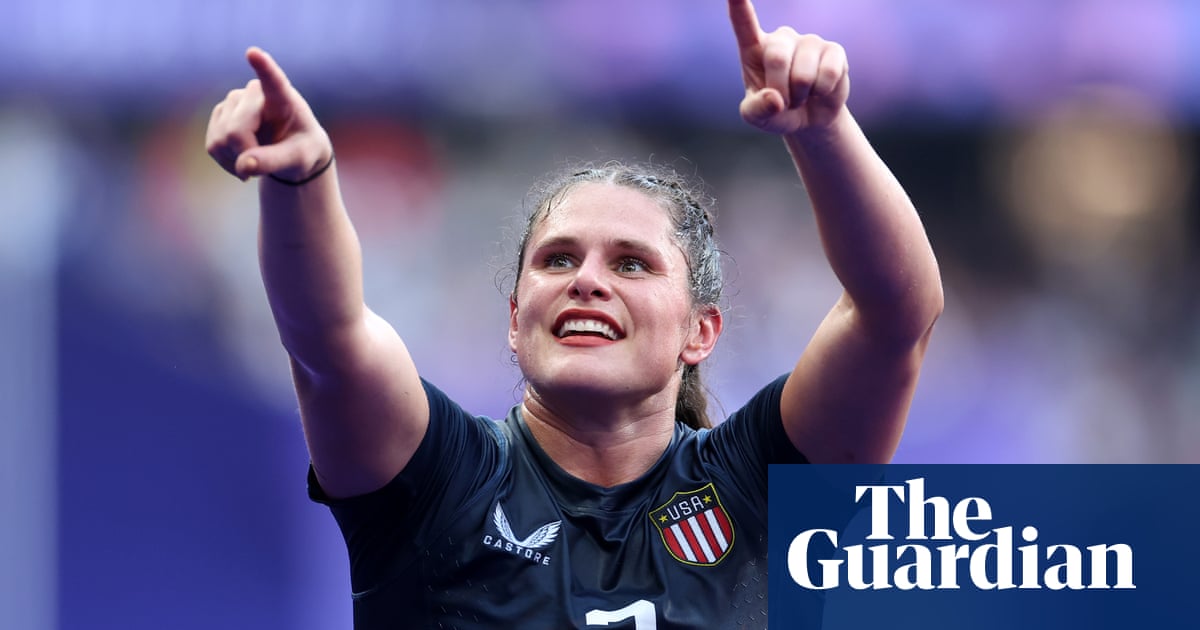Promoters for Saturday’s men’s and women’s rugby double-header in Los Angeles areoffering“VIP Courtside” seats, hailed as a chance to “feel the heart-pounding action like never before”.
“With courtside seats,” the blurb goes, “you’re not just watching the game – you’re in the middle of the intensity. Every … moment of pure adrenaline is right in front of you.”
Rugby is played on a pitch or a field. Ithas courts, but they are more usually staged on tour, rituals used to foster team unity. Nonetheless, the WNBA-esque adjacent language of the LA hard-sell is appropriate for the occasion at hand, not just because of the intimate surrounds of Wallis Annenberg Stadium, on the UCLA campus, but also given theCaitlin Clark adjacent star powerof its main attraction.
Ilona Maher, the stratospheric star of the women’s game, reality TV, swimwear shoots, social media and podcasts, is in the US squad to face Japan in the second match of the day, after the men ofRugby FC Los Angelesand the San Diego Legion play a Major League Rugby fixture.
The Eagles have a nucleus of seriously experienced star players – led by Kate Zackary, who plays No8 for Ealing in England, and Alev Kelter, a center for the Loughborough Lightning – but when it comes to ticket sales, Maher works wonders. In January, she helped Bristol set a record for Premiership Women’s Rugby. Back home, she has helped set such a mark for any women’s game in the US, for the second game on the Eagles’ spring schedule, against Canada in Kansas City next week.
“This is a landmark moment for women’s rugby in the US,” said Bill Goren, chief executive of USA Rugby,announcinga sales success seen in Kansas City at least as a sign that World Cup games could land in Missouri in 2031 (men) and 2033 (women).
“The excitement … shows that the sport is reaching new heights, and we’re thrilled that the Women’s Eagles’ journey to the Rugby World Cup [in England in August] will kick-off in front of such a massive crowd.”
All things are relative, massiveness included. USA Rugby said more than 7,500 tickets had been sold for the Canada game, which will be played at CPKC Stadium, which holds 11,500. The previous best crowd for a women’s game in the US is closer to the capacity at the Wallis Annenberg: 2,145.
On the other hand, the Kansas City record will not last long, as the Maher factor is driving another double-header – US men v England and US women v Fiji at Audi Fieldin Washington DC on 19 July– rapidly towards a 20,000 full house. It’spossiblemost of those fans have booked for a chance to see England coach Steve Borthwick in the tracksuited, taciturn flesh. It’sprobablethey are out for a chance to see Maher.
This being rugby, a sport subject to excruciating politics and logistical challenges wherever it is played, the women’s Eagles schedule is not without points of contention.
On 3-4 May, as the 15-a-side team faces Canada in Kansas City, their sevens counterparts will compete back west in LA in the final event on the HSBC world sevens circuit. Maher had made her name – and plenty of other players had made their mark – before she and the Eagles won Olympic bronze in Paris last summer but that sevens success supercharged the sense of possibility that now surrounds the women’s game. Having the sevens and 15s Eagles playing at the same time on different sides of the country is therefore frustrating to many. Come to that, the weekends of 25-26 April and 3-4 May also see games in Women’s Elite Rugby, the semi-professional 15s league now halfway through its inaugural season,making the New York Times, and home to Eagles talent.
This weekend, the women’s 15s game against Japan in Los Angeles also coincides with 64 women’s sevens teams (and 80 men’s teams) descending on Boyds, Maryland, for theCollegiate Rugby Championships, a three-day extravaganza in its 15th year, billed as the biggest college rugby tournament anywhere in the oval world.
Call it glorious profusion. Wade Smith, chief operating officer of National Collegiate Rugby, which runs the CRCs, said that though it was “difficult to quantify” the effect of Maher mania, “there’s a lot of anecdotal evidence that suggests that we’re getting a really big surge in interest within women’s college rugby”.
Heralding CRC guest appearances from Olympic sevens stars Naya Tapper, Perry Baker and Kevon Williams, and a Hall of Fameintakeincluding stars of past women’s champions from Life in Georgia and Lindenwood in Missouri, Smith added: “There will be future men’s and women’s Eagles playing on Saturday and Sunday.”
Identifying such new talent, and channeling it to the national teams, remains the great challenge for all US rugby.
Maher herself has discussed the need to find more stars.
“Right now it seems like just Ilona Maher, we need to get her in this and this,” she said in January,after her debut for Bristol. “That is where I would love to bring these teammates up … I’ve seen the power of people connecting with the individual and then going to a sport. People connect with Caitlin Clark and go see a [WNBA] game and that brings more fans in.
“So if we could have more people connect with [leading women’s players], that brings them in. That is my goal. I love being a superstar, people call me the superstar of rugby but that’s not enough for the sport. We can’t just have one superstar.”
Martin Pengelly writes on Substack atThe National Maul, on rugby in the US
